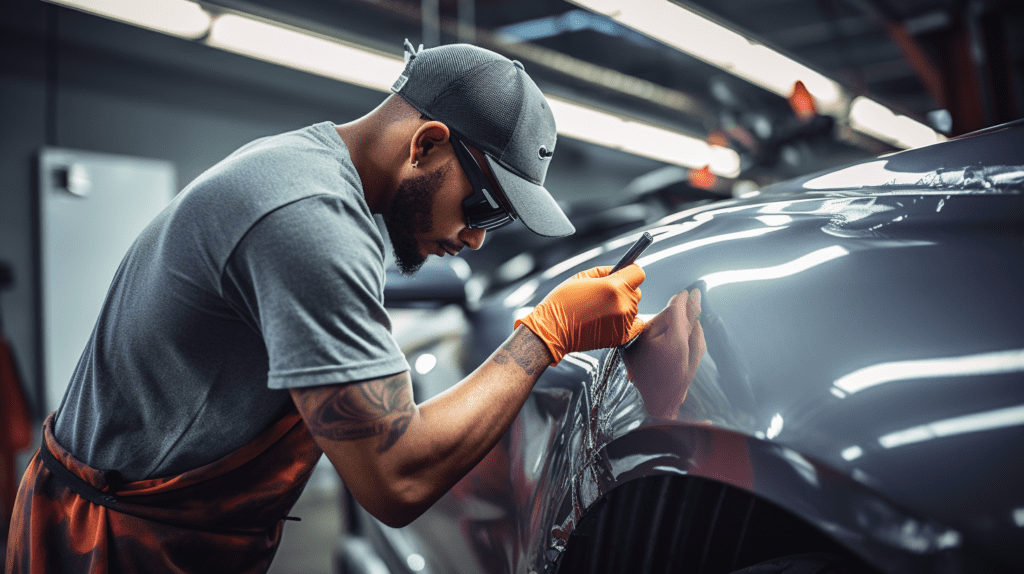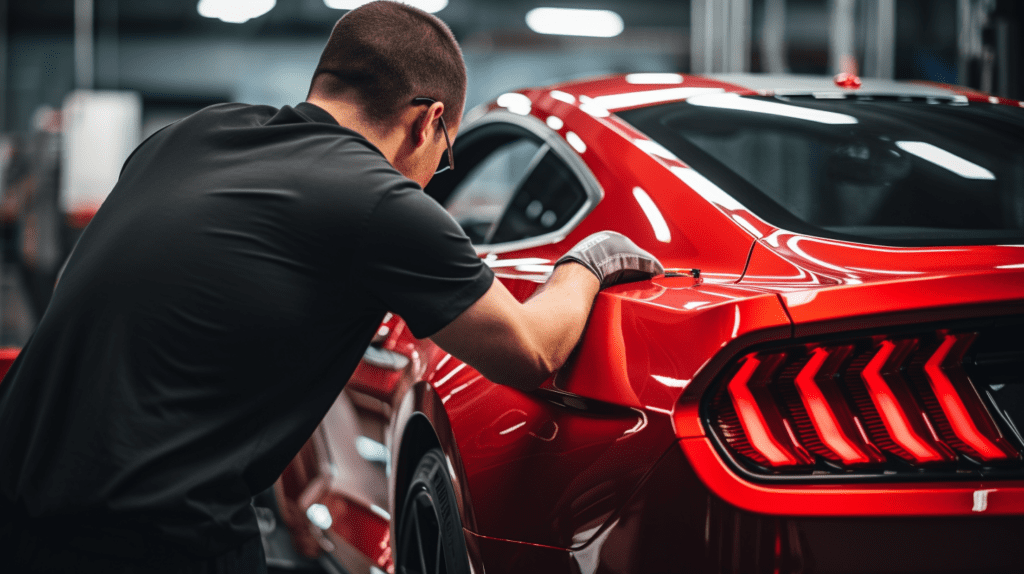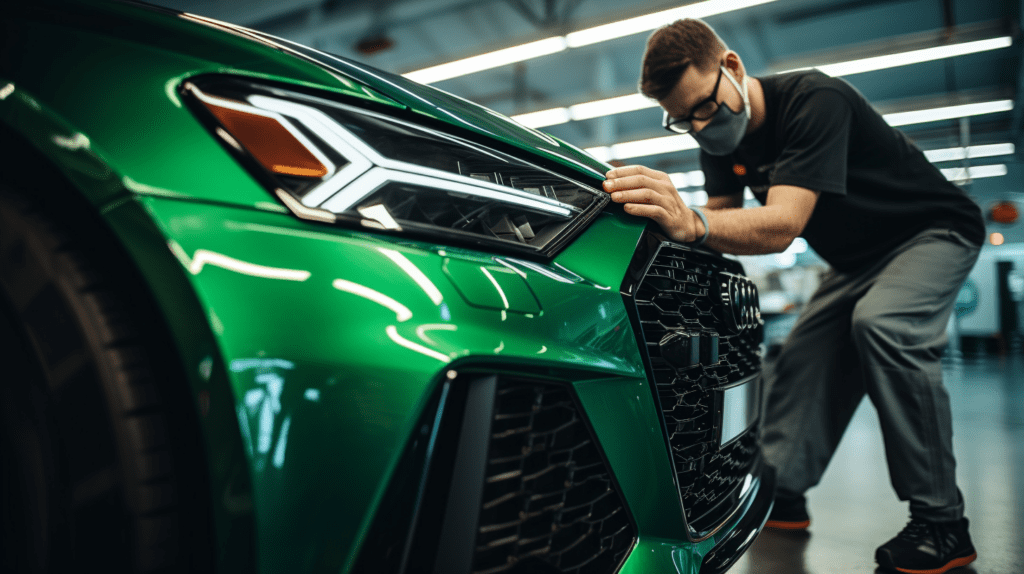Auto Dent Removal

Did you know that over 50% of auto owners will experience a dent at some point? We’ve all been there, staring at that annoying blemish on our beloved vehicles. But fear not, because in this article, we will explore the world of auto dent removal. From DIY techniques to professional services, we’ll uncover the most effective ways to restore your car’s pristine appearance. So buckle up and get ready to bid those dents farewell!
Key Takeaways
- DIY dent removal techniques include using a plunger, boiling water, a hairdryer and compressed air, or a dent removal kit.
- Professional dent removal services offered by mobile repair technicians provide convenience, quality work, and a warranty.
- Paintless dent repair is a cost-effective solution that preserves the original paint finish of the vehicle.
- Preventing auto dents can be achieved through regular inspections, parking in safe locations, utilizing protective measures, and practicing defensive driving.
Common Causes of Auto Dents
One of the most common causes of auto dents is careless parking. Whether it’s squeezing into a tight spot or misjudging the distance from other vehicles, parking mishaps can lead to unsightly dents on our cars. However, parking lot dents are not the only culprits. Hail damage is another frequent cause of auto dents.
When it comes to parking lot dents, they can occur in various ways. Opening car doors too forcefully can result in dents on neighboring vehicles. Additionally, reckless drivers who scrape or collide with parked cars can cause significant damage. Moreover, tight parking spaces and crowded parking lots increase the likelihood of dents as drivers maneuver their vehicles into limited spaces.
Hail damage is another significant cause of auto dents. During severe weather conditions, hailstones can pummel the surface of our cars, leaving behind numerous dents. The size and velocity of hailstones play a crucial role in the extent of the damage. Larger hailstones or those falling at high speeds can cause more severe dents.
To prevent common parking lot dents, it is essential to park carefully, allowing enough space between vehicles. Being mindful of other drivers and refraining from slamming car doors can also reduce the risk of dents. During hailstorms, finding sheltered parking or using car covers can help protect our vehicles from hail damage.

There are several types of dent repair methods for vehicles, each suitable for different types of dents and damage severity. Here are the main types:
Traditional Dent Repair
This method is used for dents that also have scratches, scuffs, or paint chips. The process starts with technicians removing the panels, if necessary, and using specialized tools to restore the shape. They then repair the accompanying scratches or paint chips by sanding and smoothing down the area. After the damaged area is restored to its original form and smoothed, technicians will paint the damaged area. Traditional dent repairs typically take more time than paintless dent removal due to the additional steps involved.
Paintless Dent Repair (PDR)
PDR is used for dents without any paint damage. Technicians use specialized tools and some heat to restore the shape of the dented area. Because there is no paint damage, technicians won’t need to sand or paint the area. PDRs typically reach completion within a couple of hours and are less expensive than more invasive repair options.
Different types of dents require different repair techniques. Here are some common types of dents:
- Ding: A small area of damage that can often be repaired with simple DIY methods.
- Round Dent: A circular indentation that can often be “popped” back out.
- Sharp Dent: These are usually caused by impacts from sharp objects and can be more challenging to repair.
- Creased Dent: These occur when another object strikes your car and is then dragged along. These can be particularly challenging to repair as they often damage the paint job and can alter the metal panel’s “memory”.
- Extreme Dent: These are larger and irregularly shaped dents caused by larger objects hitting your vehicle, hit and runs, people falling on your car, or an impact from an animal.
It’s important to note that not all dents can be repaired with the same method. The choice of repair method depends on the type of dent, the extent of the damage, and the material of the vehicle’s body. For instance, PDR is most effective on metal panels and may not be the best choice when repairing aluminum and plastic.
DIY Dent Removal Techniques
When it comes to removing auto dents, there are several DIY techniques that can be effective and save us time and money. Here are four techniques you can try:
- Plunger Method: This technique requires a plunger and some water. Wet the dent and place the plunger over it. Push and pull the plunger forcefully until the dent pops out. This method works best for small and shallow dents.
- Boiling Water: For plastic bumpers, boiling water can be used to remove small dents. Pour boiling water over the dent for a few minutes. Then, use your hands or a plunger to push the dent out from the inside. Be careful not to burn yourself.
- Hair Dryer and Compressed Air: This technique is suitable for small and medium-sized dents. Heat the dent with a hairdryer for a few minutes. Then, quickly spray compressed air upside down onto the dent. The rapid change in temperature can cause the metal to contract and pop the dent out.
- Dent Removal Kits: Dent removal kits are readily available in the market. These kits usually include tools like suction cups, rods, and glue tabs. Follow the instructions provided with the kit to repair the dent effectively.
Professional Dent Removal Services

Many times even a small dent may require professional dent removal services to address more complex or challenging dents. When faced with a dent that is difficult to repair using DIY techniques, it is best to seek the expertise of a mobile dent repair service. Our professionals have specialized knowledge and access to advanced dent removal tools that can effectively restore your vehicle’s appearance.
Mobile dent repair services offer the convenience of coming to your location, whether it be your home or workplace, to carry out the necessary repairs. This eliminates the hassle of having to transport your vehicle to a repair shop and allows for a more efficient and time-saving solution.
The skilled technicians employed by these services utilize a range of dent removal tools to meticulously reshape and restore the affected area. These tools include suction cups, dent pullers, and specialized rods that can be carefully maneuvered to gently massage the dent back into its original form.
By entrusting your dent removal needs to professionals, you can ensure that the repair is done correctly and without causing further damage to your vehicle. Additionally, professional dent removal services can often provide a warranty on their work, giving you peace of mind.
With a comprehensive understanding of professional dent removal services, let’s now explore the cost-effective solution of paintless dent repair in the next section.
Paintless Dent Repair: A Cost-Effective Solution
Moving on to the topic of ‘Paintless Dent Repair: A Cost-Effective Solution’, we can explore a method that offers affordability without compromising quality. Paintless dent repair (PDR) is a technique used to remove dents from a vehicle’s body without the need for repainting. Here are four cost-saving benefits and advantages of paintless dent repair:
- No need for paint: Unlike traditional dent repair methods, PDR does not require the use of paint or fillers. This eliminates the cost of materials and labor associated with repainting the affected area.
- Time-saving: PDR is a quick process that can usually be completed within a few hours. This means you don’t have to wait for days or weeks to get your vehicle back, saving you time and inconvenience.
- Lower labor costs: Since PDR is a less labor-intensive process compared to traditional dent repair, the cost of labor is significantly reduced. This makes PDR a more affordable option for dent removal.
- Retains original paint: PDR preserves the original paint finish of your vehicle, maintaining its value and preventing potential color mismatches that can occur with repainting.

Preventing Auto Dents: Tips and Tricks
Continuing with our exploration of paintless dent repair as a cost-effective solution, let’s now delve into the topic of preventing auto dents with some helpful tips and tricks. Car maintenance plays a crucial role in preventing auto dents. Regularly inspecting your vehicle and addressing any issues promptly can greatly reduce the risk of dents. One of the key dent prevention techniques is parking your car in a safe and secure location. Avoid parking near crowded areas, shopping carts, or other vehicles that may accidentally cause dents. Utilizing protective measures such as car covers, bumper guards, and door edge guards can also provide an added layer of protection. Another important aspect is being mindful of your surroundings. Be cautious when opening car doors in tight spaces to avoid hitting nearby objects. Additionally, practicing defensive driving and maintaining a safe distance from other vehicles can minimize the chances of collision-related dents. Lastly, consider investing in a dent repair kit for minor dents that can be fixed at home. By following these car maintenance and dent prevention techniques, you can keep your vehicle looking pristine and dent-free for years to come.
Frequently Asked Questions
How Long Does It Take to Fix a Dent Using Professional Dent Removal Services?
The time it takes to fix a dent using professional dent removal services can vary significantly depending on the severity of the dent, the method of repair used, and whether or not paintwork is required.
For traditional dent repair, which often involves filling the dent, sanding it smooth, and repainting the area, the process can take anywhere from a couple of days to two weeks. This is largely due to the time-consuming nature of the paintwork, which involves matching the paint color, applying multiple coats, and allowing each coat to dry completely.
On the other hand, if the damage qualifies for Paintless Dent Repair (PDR), the repair time can be significantly shorter. PDR is a method used to fix minor dents and dings where the paint has not been damaged. It involves using special tools to gently push the dented metal back into its original shape from the inside of the panel. For small dents, PDR can often be completed in less than an hour. However, for larger or more complex dents, or if there are multiple dents to be repaired, the process could take a few hours or even a full day.
Can I Use a Plunger to Remove a Dent Myself?
Yes, it is possible to use a plunger to remove a dent yourself, but the success of this method depends on several factors such as the size, location, and severity of the dent. The process involves using boiling water and a plunger to create suction over the dented area and then pulling the plunger back to pop the dent out[1][5][9]. However, this method may not work for all dents, especially those that are large, deep, or located in areas that are difficult to access with a plunger[9][13].
What Is the Average Cost of Paintless Dent Repair?
The average cost of paintless dent repair (PDR) varies depending on the size, location, and severity of the dent. On average, you can expect to pay around $150 – $250 for PDR. For light dents, the cost may be as low as $50 – $100, while medium-sized dents could cost between $75 – $300. Larger, more severe dents could cost between $300 – $500[2][6][10].
Are There Any Temporary Methods to Hide or Camouflage a Dent?
There are several temporary methods to hide or camouflage a dent. One method is to use expanding foam. You can spray the foam into the dent, let it dry, and then sand the foam so it is level with the panel surrounding the dent. This can work as a temporary solution until you are ready to have your panels professionally repaired[3]. Another method is to cover the dent with art or use super glue to hide the damage temporarily[3][7].
Is It Possible to Prevent Auto Dents Caused by Hailstorms or Extreme Weather Conditions?
Preventing auto dents caused by hailstorms or extreme weather conditions can be challenging, but there are some measures you can take. Parking your car in a garage or another covered location can help avoid hail damage. If you don’t have access to covered parking, you can use blankets or a car cover to protect your vehicle. It’s also beneficial to have a comprehensive auto insurance policy that covers hail damage. Additionally, you can invest in a special tool that uses suction to fix minor hail damage[4][8][12].
Sources:
- youtube.com/watch?v=Vzo4aJuahJ4&t=0
- copilotsearch.com/posts/paintless-dent-repair-cost-what-to-know
- incentivosoutdoor.com/2015/08/12/five-easy-ways-to-remove-or-hide-dents-on-your-own
- kbb.com/car-advice/how-to-prevent-hail-damage
- carhop.com/news/how-to-remove-dents-with-plunger
- thedentologist.com/what-does-paintless-dent-repair-pdr-cost
- elgincdjr.com/how-to-fix-car-dents-and-scratches
- dentshop.com/blog/5-simple-ways-to-protect-your-car-from-hail-damage
- familyhandyman.com/article/can-you-remove-dents-in-your-car-with-a-plunger-and-hot-water
- ezautospa.com/services/dent-repair/pricing
- carcovers.com/resources/7-diy-methods-for-removing-car-and-truck-dents
- jdpower.com/cars/shopping-guides/how-to-prevent-hail-damage
- reddit.com/r/Cartalk/comments/vdrogt/is_it_possible_to_remove_this_dent_with_a_plunger
- reddit.com/r/Miata/comments/qw3reg/how_much_should_i_be_paying_for_for_pdr_paintless
- youtube.com/watch?v=DgZw2wHtCW4
- bannerbuzz.com/blog/sneaky-tips-for-hiding-scratches-on-your-car-2
- getjerry.com/questions/how-can-i-remove-a-car-dent-with-a-plunger
